When you combine best in class Fire Protection Service with cutting edge Design
YOU GET AVANTE
We have the skills, experience and knowledge to be your preferred name when it comes to fire safety services.
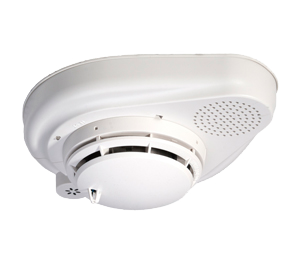
Designed to meet NFPA low-frequency signaling requirements for unattended sleeping areas, the Autocall TrueAlarm 520Hz Sounder Base is a perfect solution for hospitality, education, and multi-occupancy residential applications. It offers an efficient, cost effective way to upgrade existing Autocall systems to NFPA compliance with minimal disruption.
Highlights:
Generates 520Hz and broadband tones.
Modern, shallow, reduced diameter asymmetric design blends with the environment.
Available both with and without integrated CO sensor.
Similar installation, configuration, and programming as other Autocall units
Ideal for retrofits: Existing Autocall sensor bases can be replaced with the 520Hz Sounder Base and both the existing sensors and wiring can be re-used, minimizing cost and disruption.
Compatible with Autocall 4100ES, 4010ES, and 4007ES control panels.
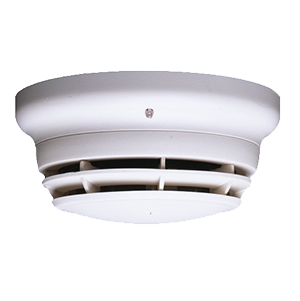
Autocall photoelectric sensors help protect your people and operations while reducing the nuisance alarms that can cause disruption to your occupants and costly downtime for your business. Autocall TrueAlarm technology addresses a major causes of nuisance alarms — dirty sensors that result in overly sensitive devices.
Highlights:
Drift compensation: Sensors evaluate environmental data and help compensate for contamination to maintain detector performance and increase nuisance alarm immunity.
Automatic sensor cleaning indication: An alert on the Autocall panel warns system operators that a sensor is dirty and requires cleaning before its maximum drift compensation level has been reached.
Seven UL-approved sensitivity levels: Each sensor can be set at the optimum sensitivity for the environment it protects down to 0.2%. You can select sensitivity levels from one of the widest sensitivity ranges in the industry, providing notable differences in response time.
Programmable day/night operation: TrueAlert sensor operation can be set to automatically adjust based on time of day, fine-tuning protection and helping to reduce false alarms.
Peak value logging: You get a historical accounting of how close each sensor has come to its alarm point, allowing you to more accurately set your system for maximum sensitivity without triggering nuisance alarms.
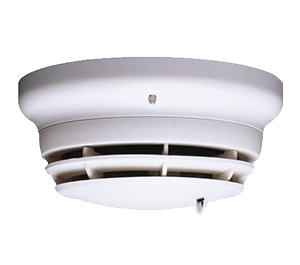
Autocall TrueAlarm Multi-Sensor Devices combine the established performances of a TrueAlarm photoelectric smoke sensor with a TrueAlarm thermal sensor to provide both features in a single sensor/base assembly. Smoke and thermal activity are correlated to provide intelligent fire detection earlier than either activity alone.
Highlights:
Special point types enable the TrueAlarm Multi-Sensor Device to communicate smoke and heat analog sensing data
A software filtering process compensates for environmental factors (dust, dirt, etc.) and component aging, significantly reducing the probability of false or nuisance alarms.
Smoke and heat sensors in the same unit can work together or operate independently.
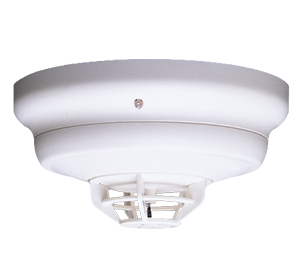
Autocall TrueAlarm addressable heat sensors provide rate-compensated, fixed-temperature sensing, selectable with or without rate-of-rise temperature sensing. Due to its small thermal mass, the sensor accurately and quickly measures the local temperature for analysis at the control panel. Rate-of-rise temperature detection is selectable at the control panel. Fixed temperature sensing is independent of rate-of-rise sensing.
Highlights:
Fixed temperature or rate of rise operation.
Programmable day/night operation: TrueAlert sensor operation can be set to automatically adjust based on time of day, fine-tuning protection and helping to reduce false alarms.
Peak value logging: You get a historical accounting of how close each sensor has come to its alarm point, allowing you to more accurately set your system for maximum sensitivity without triggering nuisance alarms.
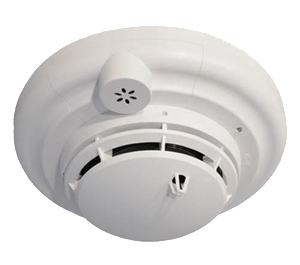
The Autocall CO Sensor Base is the ideal solution for detecting toxic CO gases in critical areas, such as residential properties, dormitories, hotels, nursing homes, and assisted living facilities. The CO sensor base has a replaceable CO element that can either work independently as a toxic gas detector or be combined with a photo or heat sensor to provide a method to reduce unnecessary alarms from common sources such as steam from showers, aerosols from personal care products, cooking materials, dust, and exhaust fumes.
The CO sensor base does not require a separate device to be mounted on the wall or ceiling. An Autocall smoke or heat sensor can plug into the base with the CO sensor element, saving mounting space as well as installation costs compared to using two independent units.
Highlights:
Reduced maintenance costs: Automatically alerts you when CO elements need to be replaced. Pop-out design allows for the replacement of only the CO element, not the entire base.
Multi-function design: CO element can operate independently or in combination with a smoke or heat sensor to help reduce unnecessary alarms or increase the photoelectric sensor’s sensitivity in high value locations.
Programmable CO condition level for OSHA: compliant CO gas sensing.
Addressable component in permanently mounted base.
Optional sounder base.
UL Listed for both UL 2034 and 2075 applications.
Extended life span: Provides approximately 10 years of service, reducing building life-cycle costs, replacement costs of CO elements, and service labor for building owners.
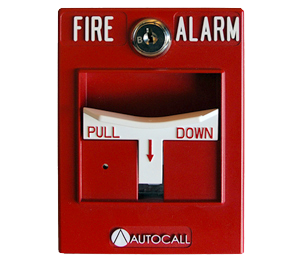
Autocall manual pull stations combine the familiar Autocall manual station housing with a compact communication module that is easily installed to satisfy demanding applications. Its integral individual addressable module (IAM) constantly monitors status and communicates changes to the connected control panel.
Highlights:
- Supports multiple operation types, including single action, double action, break glass, push operation, and single action no-grip operation to comply with ADA requirements.
- Offers individual addressability with power and data supplied via addressable communications using a single wire pair; compatible with all addressable Autocall fire alarm control panels.
- Features compact construction to minimize dust infiltration and allows for mounting in standard electrical boxes.
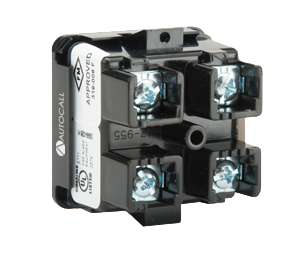
Autocall IDNet addressable modules provide addressability to conventional devices such as flow switches. Autocall products include a wide range of innovative addressable modules, including multi-point modules, modules that permit individual reporting from flow and tamper switches on the same circuit, and isolator modules that protect power wiring from short circuits and ground faults.
Highlights:
- Individual addressable modules (IAMs) receive both power and communications from a two-wire and provide location-specific addressability.
- IDNet Relay IAMs allow fire alarm control panels to control a remotely located Form “C” contact using addressable communications for both data and module power. Typical applications include switching local power for control functions, such as elevator capture, or control of HVAC components, pressurization fans, dampers, and more. Relay status is also communicated requiring only one device address.
- The Security Monitor IAM has both power and communications supplied by a two-wire 4100ES, 4100U or 4010ES IDNet circuit. It provides location-specific addressability for up to five initiating devices (such as window or door magnet switch contacts or other similar security devices) by monitoring the circuit wiring connections to either normally closed or normally open dry contacts (one type per IAM).
- The Single Address Six Point Module allows the IDNet communication channel to monitor four T-sense input circuits and control two output relays from a single compact module requiring a single address. Power is supplied by a 24 VDC connection to a listed fire alarm power supply.
- IDNet/MAPNET II Monitor ZAMs allow a single addressable point to monitor a conventional initiating device circuit (IDC) populated with 2-wire or 4-wire initiating devices.
- Communications Isolators provide IDNet communications isolation and Power Isolators provide system power isolation. The isolators improve installation convenience and increase system integrity. Isolation is automatically activated when an output short circuit is detected and isolation can also be selected manually from the control panel to assist with troubleshooting wiring problems.
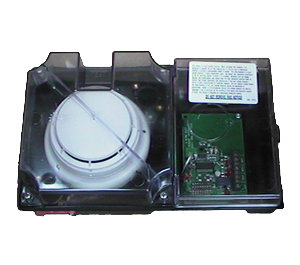
Autocall air-sampling smoke detectors are designed to detect smoke in challenging duct applications, as well as restricted areas, such as elevator shafts, electrical equipment rooms, hospital MRI rooms, and correctional facilities.
Highlights:
- Active air sampling technique and TrueAlarm smoke sensing technology for accurate, reliable monitoring of ducts
- Sensors can be located up to 82 ft. from the duct, making installation and maintenance fast and easy
- Works with Autocall addressable fire alarm control panels
- UL Listed to Standards 268A and 268 and ULC Listed to Standard S529
- Includes a test port for easy introduction of smoke source during testing
- Provides an optional water trap with drain to prevents nuisance alarms associated with condensation buildup
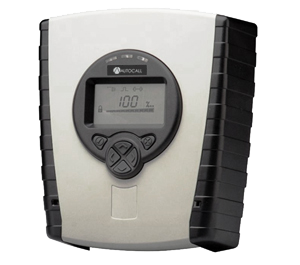
Beam detectors are used to provide open-area smoke detection in situations where it is either impractical or not cost-effective to use traditional point-type detectors or aspirating smoke detection. Some common applications include warehouses, atriums, convention centers, shopping malls, and sports arenas.
The Autocall Addressable Beam Detector provides enhanced command, control, configuration, and status/event reporting between the detector and the fire alarm control panel. Configuration, installation, diagnostics, service, and maintenance are simple and fast, saving time and money for contractors, installers, and building owners. It is compatible with Autocall 4100ES and 4010ES fire alarm control panels.
Highlights:
Auto-adjustment helps keep the beam properly aligned and functioning
Supports up to 2 detector heads reporting to one ground level controller
Offers a range of 26 ft. 3 in. to 330 ft. (8 m to 100 m)
Includes built-in laser-assisted prism mounting
Features a built-In electronic UL/ULC obscuration acceptance fire test
Provides contamination compensation
Supports fire alarm control panel operations, including sensitivity selection, almost-dirty threshold, and initiation of obscuration test
Receives fire alarm control panel information, including smoke status, controller-to-detector communications status, trouble status, analog values for signal strength, and compensation level
